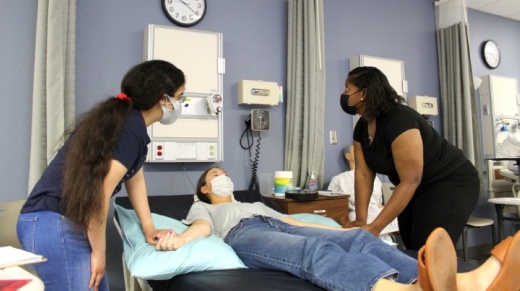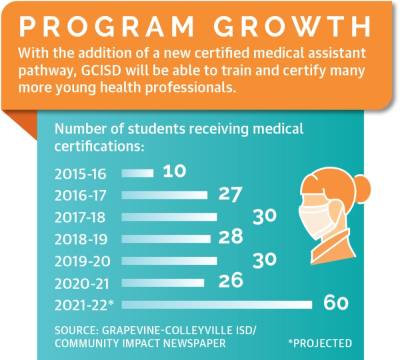The district’s new certified medical assistant pathway will provide training not covered in existing GCISD health science classes. It will also open up opportunities for students who are not interested in completing or able to complete clinical training.
“We have a ton of kids that are just really interested in health care,” GCISD Coordinator of CTE Candace McGowan said. “It’s been a really successful program.”
When GCISD opened its Technology Education and Career Center in 2013, there was one health science teacher on staff. Since then, that number has grown to six, according to the district.
The expansion of GCISD’s health science offerings comes at a time when nationwide training opportunities have decreased. According to the Association for Career and Technical Education, a 2021 survey of administrators showed that 59% of career and technical education programs shrank enrollment in the 2020-21 school year.
Respondents attributed this decrease to a mix of pandemic-related factors, including overall enrollment decreases and issues with scheduling hands-on classes. Growth in GCISD next year will feed an escalating need for skilled labor in the health care field. As the population expands and continues to age, more people will need specialized care, according to the U.S. Bureau of Labor Statistics.
GCISD offered two health science pathways for the 2020-21 school year. Students could choose to be trained as either certified nurse assistants or EMTs. They take a series of foundational classes before choosing a two-semester, hands-on practicum class their senior year.
In a normal year, students receive clinical training at hospitals or nursing homes, where they practice on real patients. This year, due to COVID-19, they practiced in class, using medical dummies or each other.
At the end of the practicum, seniors take state exams and are certified as health care workers. High school graduates then use their certifications as a foundation for further education or to start their careers.
“Sometimes people have a misunderstanding or misconception about CTE as being lesser than or lower than. ... That is not the case at all,” said Steve DeWitt, deputy executive director of the Association for Career and Technical Education. “A lot of the courses are being sought after by students who are going on to four-year colleges. They want to get the credit those courses are providing them, the employability skills, the technical skills, et cetera.”
Senior Alyssa Arnold said she plans to go to Tarrant County College for further nursing certification, while fellow nurse assistant student Omar Dar Salem said that he plans to attend Baylor University before going on to dental school.
They both said they appreciate the practical skills they learned in their health science classes.
“I’m grateful because I probably wouldn’t have done it outside of school,” Arnold said. “It helps a lot if we’re in school, and we have teachers that we know, people to help us.”
Diversifying programs
GCISD houses specialized health science facilities inside the Technology Education and Career Center. The center serves as a hub for the district’s various CTE programs, which also include marketing, hospitality and agriculture. Students are able to take CTE courses during the regular school day, alongside their traditional classes.
The new certified medical assistant pathway being offered in the fall will help GCISD grow its program. Medical assistant classes can be held in a standard classroom, unlike nursing assistant classes.
“Although there is no clinical part that’s required, I’m a hands-on person,” said Stacey Brown, the GCISD health science instructor who is developing the certified medical assistant curriculum. “You need to know what you’re going to be doing.”
Medical assistant students will not have to travel off-campus for clinical training either, Brown said, opening up access to students who might not have reliable transportation. There are also students who are interested in health care, but not nursing. The new pathway can function as another entry point.
Certified nurse assistants do care work that supports nurses, said Rick Bracy, director of career and technical services for GCISD. They often work with the elderly in nursing homes.
At GCISD, nursing classes are held in a room equipped with hospital beds, sinks and other health care amenities. Students in nursing classes practice practical skills, such as moving a patient from a bed to a wheelchair.
“They’re going to be doing the bathing ... and feeding, cleaning the room [and] things of that nature,” Bracy said. “The medical assistant is more in a doctor’s office practice. ... They may draw blood, they may take temperature, [or] they may run an EKG.”
Despite the difference in training, Brown said that hospitals have started hiring medical assistants to perform nursing duties, due to a serious need for nurses. She is crafting her curriculum to match by incorporating skills such as administering an IV. Those skills are not required for medical assistant certification, but they make students more desirable in acute care settings, she said.
“I don’t think any of these students, when they walk out of our doors, would have trouble finding a job, especially with the certification that they’re getting,” McGowan said.








